Page 59 of 338
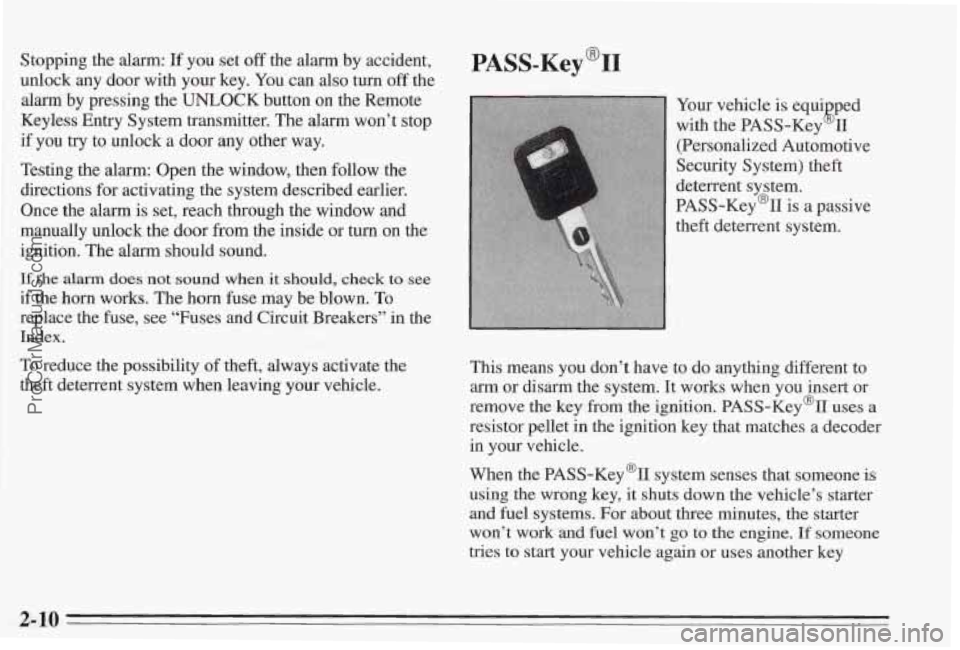
Stopping the alarm: If you set off the alarm by accident,
unlock any door with your key.
You can also turn off the
alarm by pressing the UNLOCK button on the Remote
Keyless Entry System transmitter. The
alarm won’t stop
if you try to unlock a door any other way.
Testing the alarm: Open the window, then follow the
directions for activating the system described earlier.
Once the
alarm is set, reach through the window and
manually unlock the door from the inside
or turn on the
ignition. The alarm should sound.
I€ the alarm does not sound when it should, check to see
if the horn works. The horn fuse may be blown. To
replace the fuse, see “Fuses and Circuit Breakers” in the
Index.
To reduce the possibility of theft, always activate the
theft deterrent system when leaving your vehicle.
PASS-Key@II
Your vehicle is equi -ed
with the PASS-Key II
(Personalized Automotive
Security System) theft
deterrent system.
PASS-Key(%
is a passive
theft deterrent system.
k?
This means you don’t have to do anything different to
arm or disarm the system. It works when you insert or
remove the
key from the ignition. PASS-Key% uses a
resistor pellet in the ignition key that matches a decoder
in your vehicle.
When the PASS-Key% system senses that someone is
using the wrong key, it shuts down the vehicle’s starter
and fuel systems.
For about three minutes, the starter
won’t work and
fuel won’t go to the engine. If someone
tries to start your vehicle again
or uses another key
2-10
ProCarManuals.com
Page 62 of 338
;ystem tu its higlxevt speed with
>n ECON or VENT. That will
air into
your vehicle. See Vornfo
New Vehicle “Break-In”
NOTICE:
Your modern Pontiac doesn’t need an elaborate
“break-in.” But it will perform better in the long
run if you follow these guidelines:
Don’t drive at any one speed -- fast or slow
-- for the first 500 miles (804 km). Don’t
make full-throttle starts.
Avoid making hard stops for the first 200
miles (322 km) or so. During this time your
new brake linings aren’t yet broken in.
Hard stops with new linings can mean
premature wear and earlier replacement.
Follow this “breaking-in” guideline every
time you get new brake linings.
Don’t tow a trailer during “break-in.” See
“Towing a Trailer’’ in the Index
for more
information.
2-13
ProCarManuals.com
Page 64 of 338
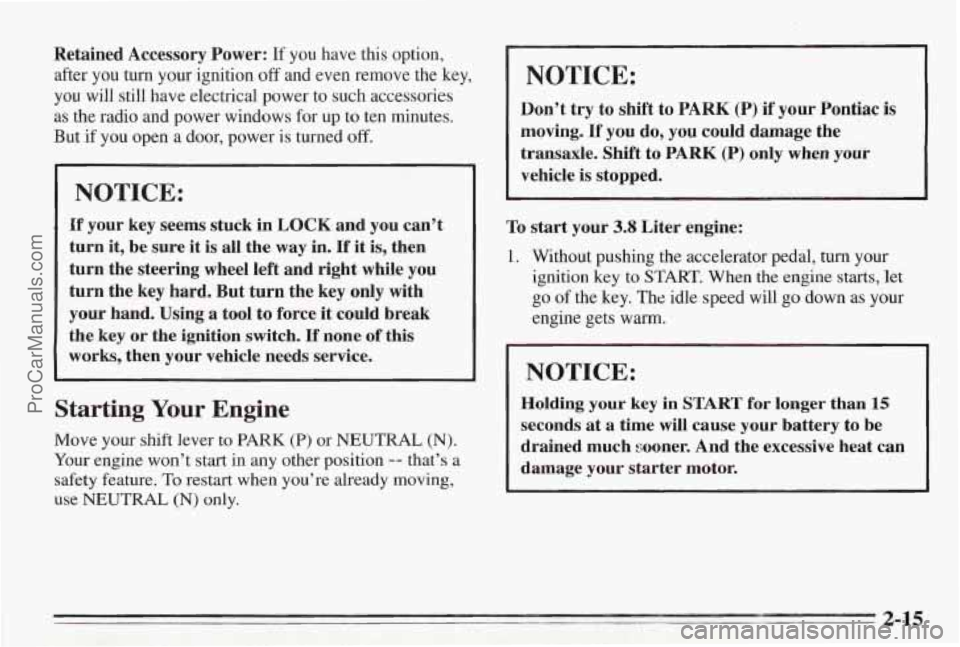
Retained Accessory Power: If you have ths option,
after you turn your ignition
off and even remove the key,
you will still have electrical power to such accessories
as the radio and power windows for up to ten minutes.
But if you open
a door, power is turned off.
NOTICE:
If your key seems stuck in LOCK and you can’t
turn it, be sure it is all the way in.
If it is, then
turn the steering wheel left and right while you
turn the key hard. But turn the key only with
your hand. Using a tool to force it could break
the key
or the ignition switch. If none of this
works, then your vehicle needs service.
Starting Your Engine
Move your shift lever to PARK (P) or NEUTRAL (N).
Your engine won’t start in any other position -- that’s a
safety feature.
To restart when you’re already moving,
use
NEUTRAL (N) only.
NOTICE:
Don’t try to shift to PARK (P) if your Pontiac is
moving. If you do, you could damage the
transaxle. Shift to PARK
(P) only when your
vehicle is stopped.
To start your 3.8 Liter engine:
1. Without pushing the accelerator pedal, turn your
ignition key to
START. When the engine starts, let
go of the key. The idle speed will go down as your
engine gets
warm.
NOTICE:
Holding your key in START for longer than 15
seconds at a time will cause your battery to be
drained much sooner.
And the excessive heat can
damage your starter motor.
2-15
ProCarManuals.com
Page 65 of 338
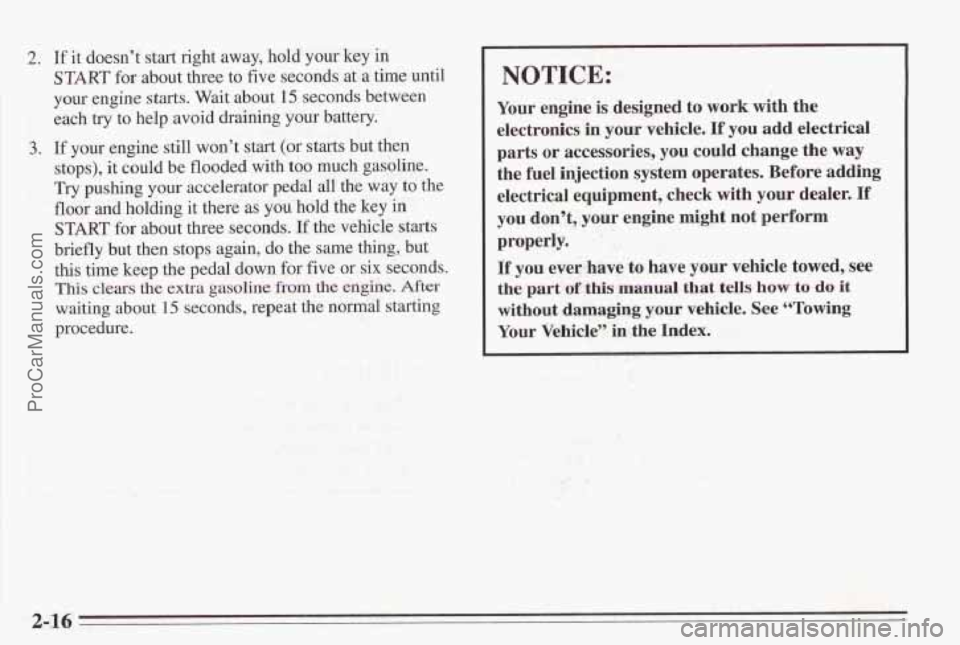
2. If it doesn’t start right away, hold your key in
START for about three to five seconds at a time until
your engine starts. Wait about
15 seconds between
each try
to help avoid draining your battery.
3. If your engine still won’t start (or starts but then
stops), it could be flooded with
too much gasoline.
Try pushing
your accelerator pedal all the way to the
floor and holding it there as you hold
the key in
START for about three seconds. If the vehicle starts
briefly but then stops again, do
the same thing, but
this
time keep the pedal down far five or six seconds.
This clears the extra gasoline €rom the engine. After
waiting about 15 seconds, repeat the nod starting
procedure.
NOTICE:
Your engine is designed to work wkh the
electronics
in your vehicle. If you add electrical
parts or accessories, you could change the way
the fuel injection system operates. Before adding
electrical equipment, check with your dealer.
If
you don’t, your engine might not perform
properly.
If you everhave to have your vehicle towed, see
the part of this manual that tells how to do it
without damaging your vehicle. See “Towing
Your Vehicle” in the lndex.
2-16
ProCarManuals.com
Page 68 of 338
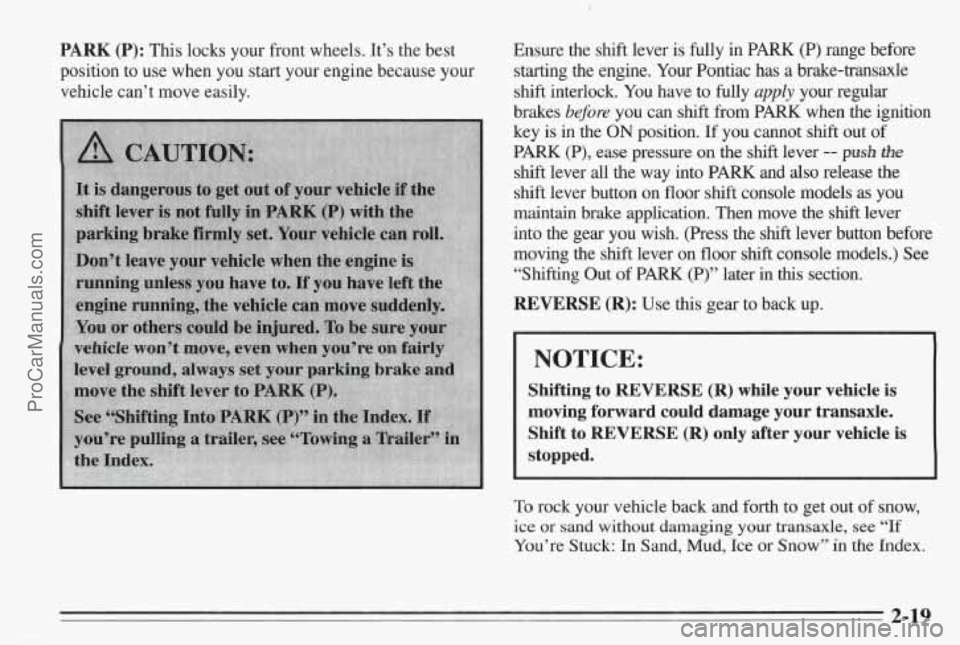
PARK (P): This locks your front wheels. It’s the best
position to use when
you start your engine because your
vehicle can’t move easily. Ensure the shift lever is fully in
PARK (P) range before
starting the engine. Your Pontiac has a brake-transaxle
shift interlock.
You have to fully apply your regular
brakes before you can shift from PARK when the ignition
key is in the
ON position. If you cannot shift out of
PARK (P), ease pressure
on the shift lever -- push t2ze
shift lever all the way into PARK and also release the
shift lever button on floor
shift console models as you
maintain brake application. Then move the shift lever
into the gear you wish. (Press the shift lever button before \
moving the shift lever on floor shift console models.) See
“Shifting Out of PARK (P)” later
in this section.
REVERSE (R): Use this gear to back up.
NOTICE:
Shifting to REVERSE (R) while your vehicle is
moving forward could damage your transaxle.
Shift to REVERSE
(R) only after your vehicle is
stopped.
To rock your vehicle back and forth to get out of snow,
ice or sand without damaging your transaxle, see “If
You’re Stuck: In Sand, Mud, Ice or Snow” in the Index.
2-19
ProCarManuals.com
Page 81 of 338
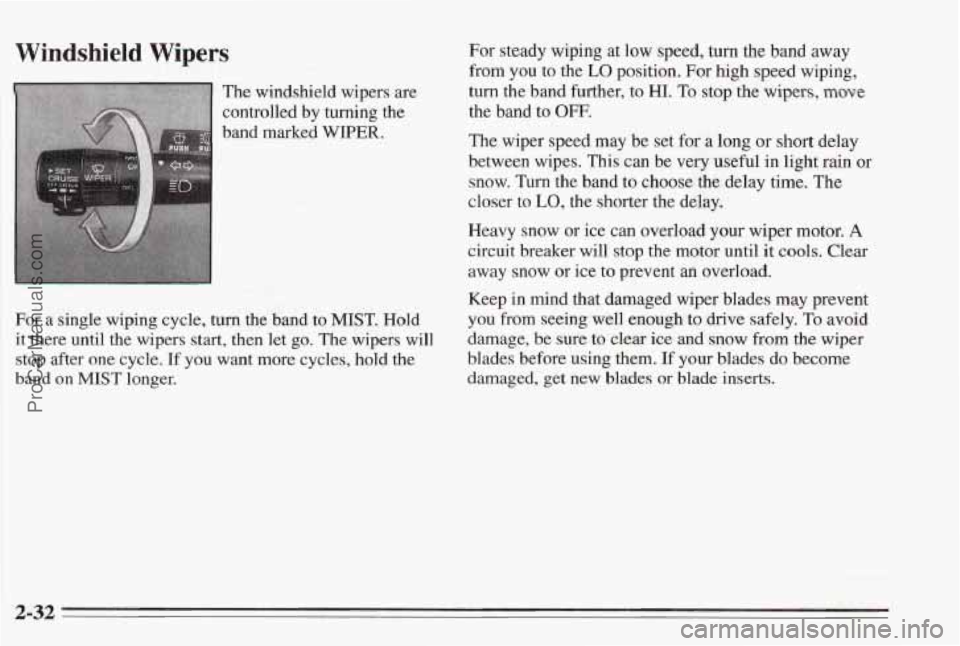
Windshield Wipers
The windshield wipers are
controlled by
turning the
band marked WIPIER.
For steady wiping at low speed, turn the band away
from you to the LO position. For high speed wiping,
turn the band further, to HI. To stop the wipers, move
the band to OFF.
The wiper speed may be set for a long or short delay
between wipes. This
can be very useful in light rain or
snow. Turn the band to choose the delay time. The
closer to
LO, the shorter the delay.
Heavy snow or ice can overload
your wiper motor. A
circuit breaker will stop the mator until it cools. Clear
away snow
or ice to prevent an overload.
Keep
in mind that damaged wiper blades may prevent
For a single wiping cycle,
turn the band to MIST. Hold you from seeing well enough to drive safely. To avoid
it there until the wipers start, then let go. The wipers will damage, be sure to clear ice and snow from the wiper
stop after one cycle.
If you want more cycles, hold the blades before using them. If your blades do become
band on MIST longer. damaged, get new blades or blade inserts.
2-32
ProCarManuals.com
Page 92 of 338
Convenience Net (Option)
Your vehicle may have a convenience net. You’ll see it
just inside the back wall of the trunk.
Put small loads, like grocery bags, behind the net. It can
help keep them from falling over during sharp turns or
quick starts and stops.
The net isn’t for larger, heavier loads. Store them in the
trunk as far forward as you can.
You can unhook the net
so that it will lie flat when
you’re not using it.
Card Holder
The front doors on some vehicles have a card holder for
convenient storage
of business cards or parking lot ticket
stubs. The card holder
has space for up to five regular
business
cards.
2-43
ProCarManuals.com
Page 102 of 338
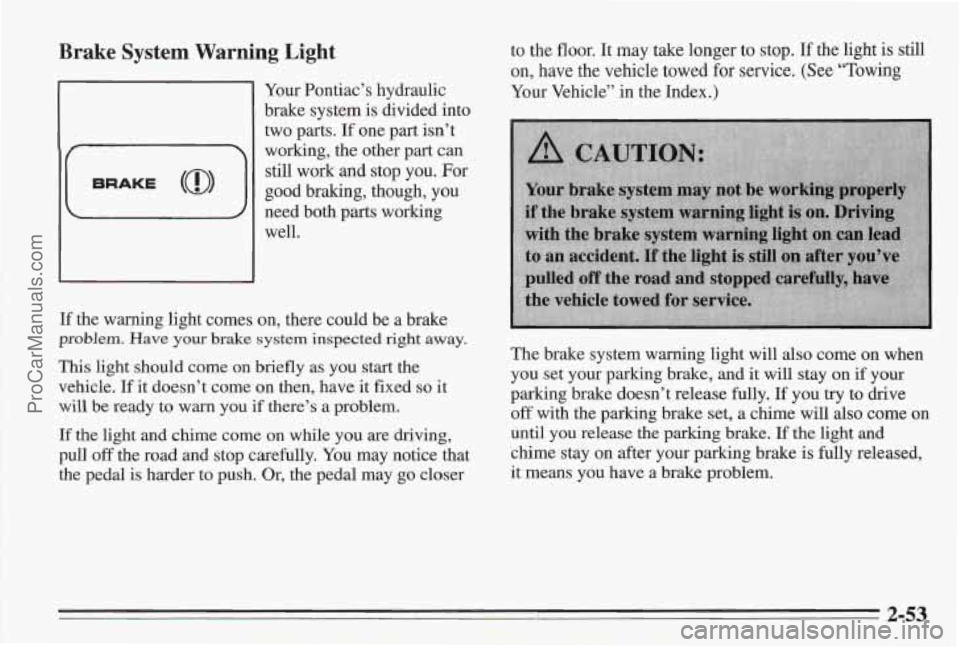
Brake System Warning Light
Your Pontiac’s hydraulic
brake system is divided into
two parts.
If one part isn’t
working, the other part can
still work and stop you.
For
good braking, though, you
need both parts working
well.
If the warning light comes on, there could be a brake
problem. Have your brake system inspected right awav.
This light should come on briefly as you start the
vehicle.
If it doesn’t come on then, have it fixed so it
will be ready to warn you if there’s a problem.
If the light and chime come on while you are driving,
pull
off the road and stop carefully. You may notice that
the pedal is harder to push. Or, the pedal may go closer to
the floor. It may take longer to stop. If the light
is still
on, have the vehicle towed for service. (See “Towing
Your Vehicle” in the Index.)
The brake system warning light will also come on when
you set your parking brake, and it will stay on if your
parking brake doesn’t release fully.
If you try to drive
off with the parking brake set, a chime will also come on
until you release the parking brake. If the light and
chime stay on after your parking brake is fully released,
it means you have a brake problem.
2-53
ProCarManuals.com